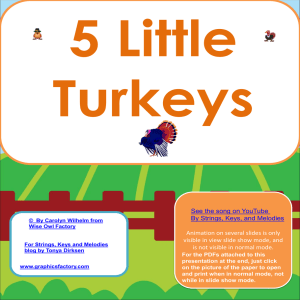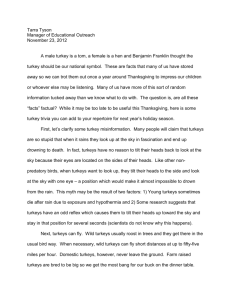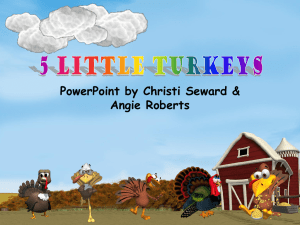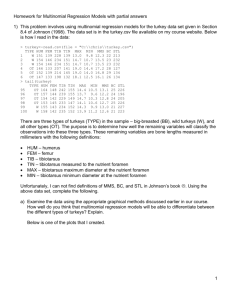Document 11871827
advertisement
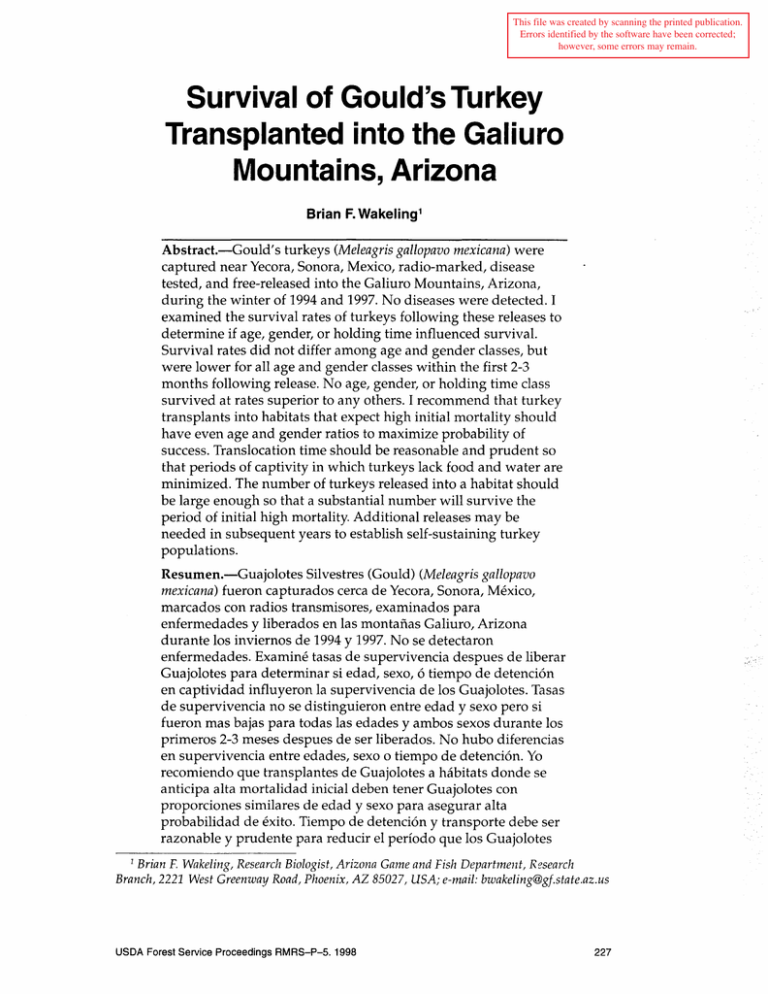
This file was created by scanning the printed publication. Errors identified by the software have been corrected; however, some errors may remain. Survival of Gould's Turkey Transplanted into the Galiuro Mountains, Arizona Brian F. Wakeling 1 Abstract.-Gould's turkeys (Meleagris gallopavo mexicana) were captured near Yecora, Sonora, Mexico, radio-marked, disease tested, and free-released into the Galiuro Mountains, Arizona, during the winter of 1994 and 1997. No diseases were detected. I examined the survival rates of turkeys following these releases to determine if age, gender, or holding time influenced survival. Survival rates did not differ among age and gender classes, but were lower for all age and gender classes within the first 2-3 months following release. No age, gender, or holding time class survived at rates superior to any others. I recommend that turkey transplants into habitats that expect high initial mortality should have even age and gender ratios to maximize probability of success. Translocation time should be reasonable and prudent so that periods of captivity in which turkeys lack food and water are minimized. The number of turkeys released into a habitat should be large enough so that a substantial number will survive the period of initial high mortality. Additional releases may be needed in subsequent years to establish self-sustaining turkey populations. Resumen.-Guajolotes Silvestres (Gould) (Meleagris gallopavo mexicana) fueron capturados cerca de Yecora, Sonora, Mexico, marcados con radios transmisores, examinados para enfermedades y liberados en las montafias Galiuro, Arizona durante los inviernos de 1994 y 1997. Nose detectaron enfermedades. Examine tasas de supervivencia despues de liberar Guajolotes para determinar si edad, sexo, 6 tiempo de detenci6n en captividad influyeron la supervivencia de los Guajolotes. Tasas de supervivencia nose distinguieron entre edad y sexo pero si fueron mas bajas para todas las edades y ambos sexos durante los primeros 2-3 meses despues de ser liberados. No hubo diferencias en supervivencia entre edades, sexo o tiempo de detenci6n. Yo recomiendo que transplantes de Guajolotes a habitats donde se anticipa alta mortalidad inicial deben tener Guajolotes con proporciones similares de edad y sexo para asegurar alta probabilidad de exito. Tiempo de detenci6n y transporte debe ser razonable y prudente para reducir el periodo que los Guajolotes 1 Brian F. Wakeling, Research Biologist, Arizona Game and Fish Department, Research Branch, 2221 West Greenway Road, Phoenix, AZ 85027, USA; e-mail: bwakeling@gf.state.az.us USDA Forest Service Proceedings RMRS-P-5. 1998 227 pasan sin agua y alimento. El numero de Guajolotes liberados debe ser suficientemente grande para asegurar que un numero substancial sobrevive el periodo inicial de alta mortalidad. En afios subsecuentes, es posible que mas transplantes de Guajolotes tendnin que ocurrir para establecer poblaciones que se bastan a si mismas. INTRODUCTION Multiple efforts have been made to reestablish Gould's turkey to its former range in southern Arizona. Initial efforts in 1983 and 1985 to. reestablish a population of Gould's turkey within the Huachuca Mountains along the U.S.-Mexican border met with obstacles when >55% of the birds died during a mandatory 30-day quarantine period following their translocation from Chihuahua, Mexico (Breland 1988). This quarantine was substantially longer than time periods which turkeys are held for most trap-and-transplant programs. As a result of the high mortality during quarantine, only 21 turkeys were released (9 in 1983, 12 in 1985) (Breland 1988). This reestablishment effort was further exacerbated when suspicions of the continued presence of Merriam's turkeys (M.g. merriami), from a prior release, arose following release of the surviving Gould's turkeys into the Huachuca Mountains. Current population estimates for the Huachuca Mountains are 50-90 birds (J. Millican, Ariz. Game and Fish Dep., pers. commun., S. Stone, Fort Huachuca Army Garrison, pers. commun.). Despite the limited success of the reestablishment effort, concerns about high mortality during the quarantine period halted further efforts at trap-andtransplant activities to reestablish Gould's turkey into Arizona from Mexico (R. Engel-Wilson, Ariz. Game and Fish Dep., pers. commun.). Trap-and-transplant programs have contributed substantially to the recovery of the nation-wide turkey population from a low during the 1920s to its current status of huntable populations in 49 states today (Kennamer et al. 1992). Trap-and-transplant techniques employ the capture of free-ranging turkeys via drug consumption, funnel-entrance traps, box traps, drop nets, or rocket or cannon nets (Baldwin 1947, Glazener et al. 1964, Williams 1966, Bailey et al. 1980), and rapid translocation of captured turkeys to a suitable release site where they are free-released into the wild. This technique has proved far more successful in establishing and augmenting turkey populations than has efforts to do so with penreared turkeys (Bailey and Putnam 1979). In 1994, a plan to temporarily eliminate the need for the mandatory quarantine period when crossing the U.S.-Mexican border with turkeys was implemented. Efforts to reestablish Gould's turkeys into Arizona 228 USDA Forest Service Proceedings RMRS-P-5. 1998 were reinitiated. Free-ranging Gould's turkeys were captured near Yecora, Sonora, Mexico, and free-released into the Galiuro Mountains in southcentral Arizona. Twenty-one turkeys were released in February 1994, and 46 more were released in January and February 1997. Because several factors differed between the 1994 and 1997 releases, I evaluated the survival of Gould's turkeys post-release to determine if those factors influenced survival rates. My objective in this study was to examine survival rates following release and determine if age, gender, or holding time influenced those rates. My ultimate objective was to recommend suitable changes to future trap-and-transplant procedures to maximize the probability of success. · STUDY AREA Gould's turkeys were released near High Creek (at Knob Tank) in the Galiuro Mountains, in south-central Arizona, during February 1994 and January and February 1997. The Galiuro Mountains are steep and broken, containing narrow, deep canyons and rugged cliffs at higher elevations. The area turkeys explored following release encompassed about 1,100 km2 • Elevations ranged from 750 to 2,300 m. The study area was composed of madrean evergreen woodland (49.3% of area), semidesert grassland (39.4%), interior chaparral (6.3o/o), plains and great basin grassland (3.2%), and petran montane conifer forest (1.7%) (Brown et al. 1979). Ponderosa (Pinus ponderosa) and Chihuahuan pine (P.leiophylla) are common in higher elevations and canyons, as are Douglas-fir (Pseudotsuga menziesii). Aspen (Populus tremuloides) occurred, but only within Ash Creek. Numerous oaks (Quercus gambelii, Q. turbinella, Q. emoryi, Q. oblongifolia) were common throughout the mountain range, as was juniper (Juniperus deppeana, J. monosperma). Pinyon pine (Pinus edulis) occurred only in the northern portion of the mountain range. Grasslands occurred mainly in lower elevations between mountain ridges. METHODS I radio-marked each turkey with a motion-sensing telemetry unit (Model LB-400, Telonics, Inc., Mesa, Ariz.) prior to release. A cloacal swab was taken from each turkey and used to test for the presence of avian influenza and Newcastles' disease. Fecal samples were tested for salmonella. During 1994, all turkeys were free-released after translocation (about 95 hrs after capture) at the Knob Tank-High Creek release site. All21 turkeys (12 adult female, 9 subadult male) were free-released on February USDA Forest Service Proceedings RMRS-P-5. 1998 229 2, 1994. In 1997, turkeys were free-released in 8 separate events (Table 1) at the Knob Tank-High Creek release site (<48 hrs after capture). Table 1. Date, age and gender composition, and approximate holding time for Gould's turkeys released into the Galiuro Mountains, Arizona, 1997. Release date Age and gender composition Approximate holding time Jan 10, 1997 Jan 23, 1997 Jan 24, 1997 Jan 27,1997 Jan 30, 1997 Feb 5, 1997 Feb 11, 1997 Feb 12, 1997 2 adult female 4 subadult male, 1 adult female 2 adult male 2 subadult male, 4 subadult female, 6 adult female 1 adult female 11 adult male 5 adult female 2 subadult female, 6 adult female 48 hrs 24 hrs 24 hrs 24 hrs · 48 hrs 24hrs 24 hrs 24 hrs I aerially monitored radio-marked turkeys >1X monthly to document their survival following release. I visually monitored females during June through September at infrequent intervals to determine if they had successfully nested and brooded young. Survival data was evaluated using MICROMORT (Heisey and Fuller 1985). I evaluated survival rates by monthly time intervals and combined those months with survival rates that did not differ (P ~ 0.05) using a Z test (Heisey and Fuller 1985). I used Z tests to conduct pairwise comparisons to determine if survival rates differed by age and gender. RESULTS Disease tests isolated no positive cultures for any of the pathogens tested for. All turkeys captured and tested from the Yecora, Sonora, Mexico population during 1994 and 1997 showed no exposure to avian influenza, N ewcastles' disease, or salmonella. Following the first release effort in 1994, turkeys suffered substantial mortality before reproduction could occur. All subadult male turkeys released during 1994 died within the first 2 months following release. I was unable to detect any nesting attempts by adult females during spring 1994. By the end of August 1994, only 7 female turkeys remained alive. By June 1995,4 females remained alive. The last female died in October 1996. The second release effort in 1997 suffered similarly high initial mortality. By June 1997, 9 turkeys (1 adult male, 2 subadult males, 5 adult females, and 1 subadult female) remained alive. Although I was again unable to detect any nesting attempts during spring of 1997, frequency of turkey mortalities declined. By January 1998, only 1 additional adult female died. 230 USDA Forest Service Proceedings RMRS-P-5. 1998 :- -·~. '. When evaluating survival rates, I detected no differences (P > 0.10) between the first and second release efforts. Consequently, I pooled monthly survival rates across years. Monthly survival rates for all age and gender classes exhibited similar trends during monthly time intervals 120 . - - - - - - - - - - - - - - - - - , 100 __ ......-4---~!--l---~---~---~----;--------. 80 --l--+------···--'1'::: _ _ _ \±_ _____ .--... -A-d_u_lt-f-em-al_e_.y-r-.1--. / +·Adult female. other I I -····--····:-······-······-········--·····-·········-······-·····-·········-·-·········-·---··············-·-····-·-·-· +Adult male. yr 1 60 I 1 I 40 ·······-I············--·········-··········-···-··-···--·-····-···········-··············-·········································-···· \ \ • Subadult female, yr 1 -*·Subadult male, yr 1 I ---~ 20 ·-······-· ---·····--····--······---·····-·-······--·······-·-······--·····---····--··················---·····---·····--····---······-······ Figure 1. Monthly survival rates for age, gender, and time since release classes in the Galiuro Mountains, Arizona, 1994-1997. following release (Figure 1). Only adult females during years following the first year of release exhibited elevated survival rates during the February through March time period (Z = 2.326, P = 0.019). Gould's turkeys suffered lower survival rates during the first 2-3 months following release than they did in the remainder of their first year (Table 2). Adult male turkey survival rates during the first 3 months after release differed from the remaining 9 months during the first year (Z = 12.756, P < 0.001). Adult female survival rates differed between the first 2 months and the latter 10 months during the first year (Z = 6.686, P < 0.001), although there was no difference between survival rates during these time periods in subsequent years for adult female turkeys (Z = 0.679, P = 0.542). Subadult male (Z = 3.056, P = 0.002) and females (Z = 7.139, P < 0.001) also differed between the first 2 months following release and the latter 10 months during the first year. I detected no difference in survival between age and gender classes during either the first 2-3 months or the latter 9-10 months of the first year (P > 0.145). USDA Forest Service Proceedings RMRS-P-5. 1998 231 Table 2. Age and gender-specific survival rates (variance) by time period following release for Gould's turkeys transplanted during winter 1994 and 1997 in the Galiuro Mountains, Arizona. Period Adult male, first year Feb-Mar 0.098 (0.005) Apr-Jan 1.000 (0.000) a Adult female, first year Subadult male, Subadult female, Adult female, first year first year subsequent years 0.408 (0.013) 0.359 (0.044) 0.097 (0.016) 0.859 (0.015) 0.707 (0.014) 1.000 (0.000) 1.000 (0.000) 0.682 (0.030) Periods for adult male, first year: Feb-Apr and May-Jan. DISCUSSION Turkeys suffered high initial mortality rates for 2-3 months following release regardless of time held prior to release, age, or gender. There did not seem to be any superior class that survived better than another. This depressed initial survival might be used to encourage resource managers to investigate predator removal or release acclimation pens to improve initial survival. Because of the topography and vegetative cover of the Galiuro Mountains and the large-scale movements exhibited by the turkeys after release, I believe that predator removal could not affect a sufficiently large area and temporary holding birds within acclimation pens might only postpone high mortality during exploration of available habitat. Differential survival rates at different release sites may depend on predator densities and structural characteristics of transplant sites. Because survival rates improve 2-3 months following release, I recommend that future releases contain sufficient numbers of turkeys to ensure that a substantial number will survive through the exploration period. Multiple releases in subsequent years may be necessary to establish a self-sustaining population. Survival rates of Gould's turkeys in the Galiuro Mountains following the period of initial high mortality were comparable to those of other established turkey populations. Annual mean mortality rates of 30% seem common in stable or increasing turkey populations (Kurzejeski et al. 1987, Wakeling 1991). Nest success seems to be the factor that most affects turkey populations (Roberts et al. 1995, Roberts and Porter 1996). Although in southwestern turkey populations, enhancing the propensity for yearling females to nest has the greatest probability of increasing turkey population size (Wakeling and Rogers 1998). I believe that there is little evidence to suggest that time held in captivity or age and gender ratios have limited reestablishment efforts. I speculate that once the turkeys become familiar with the habitats that they have been released in, their survival rates increase. Certainly, translocation efforts should occur in the shortest period of time possible to minimize 232 USDA Forest Service Proceedings RMRS-P-5. 1998 stresses associated with the lack of food and water during translocation. But differences of 24-95 hrs in transport time had no discernable effect on turkey survival rates. Age and gender did not influence survival rates. Consequently, sufficient numbers are necessary to ensure that enough of each age and gender will survive to successfully breed. In a habitat where high initial mortality may occur, an even sex ratio may be superior to the 1 male to 4 females recommended by Hoffman et al. (1993). In this type of habitat, approaching an even ratio of subadult and adult birds in the release group is also desirable because turkeys may not breed during the first year following transplant. Breeding during the year of release has been documented ·in southwestern ranges (S. Albert, Zuni Wildl. Dep., pers. commun.) and should not be universally discounted. However, yearling females may not breed in the Southwest (Wakeling 1991) and may not contribute reproductively during the first year. Alternately, adult birds, with a mean life expectancy of 3 years (Wakeling 1991), may not have sufficient longevity to breed in subsequent years if they do not breed the first year. An even age ratio may best prepare transplanted populations to take advantage of habitat and climatic conditions at the release site. ACKNOWLEDGMENTS This manuscript is truly a result of numerous cooperating agencies and people. The capture, release, and monitoring was facilitated by the Arizona Game and Fish Department, National Wild Turkey Federation, USDA Forest Service, Centro Ecologico de Sonora, IMADES, and USDA Animal/Plant Health Inspection Service. A partial list of personnel that made this study possible includes R. W. Engel-Wilson, F. Abarca, M. Haro R., J. C. Morales L., J. E. Kennamer, J. S. Elliott, J. Heffelfinger, R. Olding, R. E. Schweinsburg, J. C. deVos, Jr., A. Moorehouse, V. Nettles, R. Spaulding, W. R. Mannan, and P.R. Krausman. Numerous individuals assisted in the trap-and-transplant efforts. I am grateful to S. MacVean for translating the abstract. This research was funded by a Research Grant by the National Wild Turkey Federation and through the Federal Aid in Wildlife Restoration Project W-78-R. LITERATURE CITED Bailey, R. W., and D. J. Putnam. 1979. The 1979 turkey restoration survey. Turkey Call 6(3):28-30. Bailey, W., D. Dennett, H. Gore, J. Pack, R. Simpson, and G. Wright. 1980. Basic considerations and general recommendations for trapping the wild turkey. Proc. Natl. Wild Turkey Symp. 4:10-23. USDA Forest Service Proceedings RMRS-P-5. 1998 233 Baldwin, W. P. 1947. Trapping wild turkeys in South Carolina. J. Wildl. Manage. 11:24-36. Breland, W. R. 1988. Reintroduction of the Gould's turkey in southeastern Arizona. Proc. Western Wild Turkey Workshop 4:12-26. Brown, D. E., C. H. Lowe, and C. P. Pase. 1979. A digitized classification system for the biotic communities of North America, with community (series) and association examples for the Southwest. Journal of the Arizona-Nevada Academy of Science 14 (suppl. 1):1-16. Glazener, W. C., A. S. Jackson, and M. L. Cox. 1964. The Texas drop-net turkey trap. J. Wildl. Manage. 28:280-287. . Heisey, D. M., and T. K. Fuller. 1985. Evaluation of survival and causespecific mortality rates using telemetry data. J. Wildl. Manage. 49:668-674. Hoffman, R. W., H. G. Shaw, M.A. Rumble, B. F. Wakeling, C. M. Mollohan, S.D. Schemnitz, R. Engel-Wilson, and D. A. Hengel. 1993. Management guidelines for Merriam's wild turkeys. Colo. Div. Wildl. Rep. 18. Fort Collins. 24pp. Kennamer, J. E., M. Kennamer, and R. Brenneman. 1992. History. Pages 617 in J. G. Dickson, ed. The wild turkey: biology and management. Stackpole Books, Harrisburg, PA. Kurzejeski, E. W., L. D. Vangilder, and J. B. Lewis. 1987. Survival of wild turkey hens in north Missouri. J. Wildl. Manage. 51:188-193. Roberts, S.D., J. M. Coffey, and W. F. Porter. 1995. Survival and reproduction of female wild turkeys in New York. J. Wildl. Manage. 59:437-447. and W. F. Porter. 1996. Importance of demographic parameters to annual changes in wild turkey abundance. Proc. Natl. Wild Turkey Symp. 7:15-20. Wakeling, B. F. 1991. Population and nesting characteristics of Merriam's turkey along the Mogollon Rim, Arizona. Ariz. Game and Fish Dep. Tech. Rep. 7., Phoenix. 48pp _ _,and T. D. Rogers. 1998. Summer resource selection and yearlong survival of male Merriam's turkey in north-central Arizona. Ariz. Game and Fish Dep. Tech. Rep., Phoenix. In press. Williams, L. E., Jr. 1966. Capturing wild turkeys with alpha-chloralose. J. Wildl. Manage. 30:50-56. __J BIOGRAPHICAL SKETCH Brian F. Wakeling received a B.S. in Wildlife Management and an M.S. in Environmental Resources from Arizona State University. He has been conducting research on Arizona's Merriam's and Gould's turkeys for the past 10 years. Prior to working on turkeys, Brian was involved in desert bighorn sheep and black bear research in Arizona. Brian serves as a Technical Representative from Arizona to the National Wild Turkey Federation and is a Past-President of the Arizona Chapter of The Wildlife Society. 234 USDA Forest Service Proceedings RMRS-P-5. 1998 ~. • j

